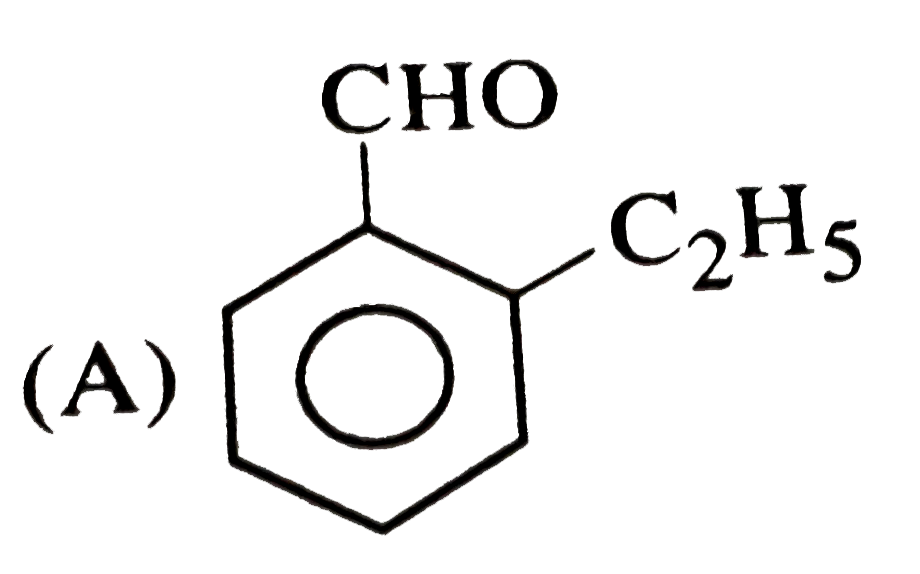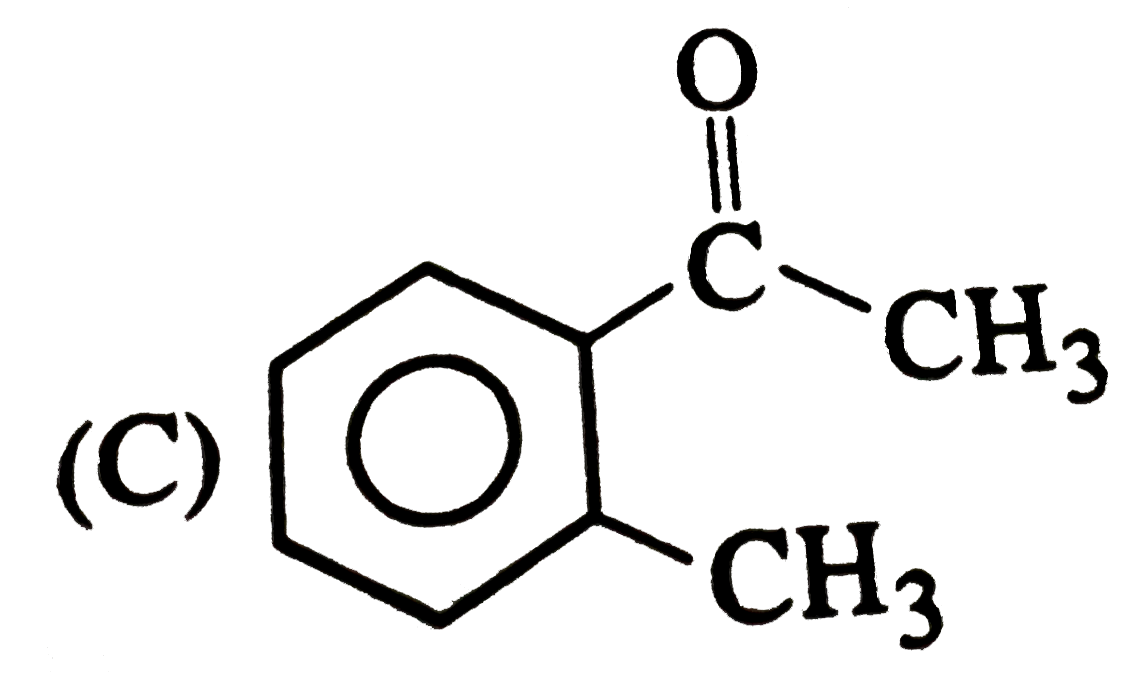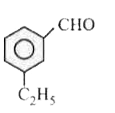An aromatic compound X with molecular formula C9H10O gives following chemical tests:
(i) Form 2,4-DNP derivative
(ii) Reduces Tollen's reagent
(iii) undergoes Cannizzaro's reaction
(iv) On vigorous oxidation 1, 2-Benzene dicarboxylic acid is obtained
The compound X is ,




The correct Answer is:A
To determine the structure of the aromatic compound X with the molecular formula C₉H₁₀O, we will analyze the given chemical tests step by step.
Step 1: Analyze the Chemical Tests
1. Formation of 2,4-DNP derivative: This indicates that compound X contains a carbonyl group (C=O), which is characteristic of aldehydes and ketones.
2. Reduces Tollen's reagent: This test is specific for aldehydes, as only aldehydes can reduce Tollen's reagent to produce a silver mirror. This suggests that compound X is likely an aldehyde.
3. Undergoes Cannizzaro's reaction: Cannizzaro's reaction occurs in aldehydes that lack alpha-hydrogens. This means that compound X must be an aldehyde without alpha-hydrogens.
4. On vigorous oxidation, 1,2-benzene dicarboxylic acid is obtained: This indicates that the oxidation of compound X leads to the formation of a dicarboxylic acid, suggesting that compound X has substituents that can be oxidized to carboxylic acids.
Step 2: Determine the Structure of Compound X
Given the information from the tests, we can deduce the structure of compound X.
- Since it is an aromatic compound with a carbonyl group and no alpha-hydrogens, it is likely to be an aromatic aldehyde.
- The oxidation leading to 1,2-benzene dicarboxylic acid suggests that the structure has substituents that can be oxidized.
A suitable candidate for compound X is 2-ethylbenzaldehyde (or o-ethylbenzaldehyde), which has the following structure:
CHO∣C6H4−CH2−CH3
Step 3: Verify the Molecular Formula
- Count the number of carbon atoms:
- Benzene ring contributes 6 carbons.
- Ethyl group contributes 2 carbons.
- Aldehyde contributes 1 carbon.
- Total = 6 + 2 + 1 = 9 carbons (C₉).
- Count the number of hydrogen atoms:
- The benzene ring contributes 4 hydrogens (due to substitution).
- The ethyl group contributes 5 hydrogens.
- The aldehyde contributes 1 hydrogen.
- Total = 4 + 5 + 1 = 10 hydrogens (H₁₀).
- There is 1 oxygen from the aldehyde group (O).
Thus, the molecular formula is confirmed as C₉H₁₀O.
Conclusion
The compound X is 2-ethylbenzaldehyde.
---
1. Formation of 2,4-DNP derivative: This indicates that compound X contains a carbonyl group (C=O), which is characteristic of aldehydes and ketones.
2. Reduces Tollen's reagent: This test is specific for aldehydes, as only aldehydes can reduce Tollen's reagent to produce a silver mirror. This suggests that compound X is likely an aldehyde.
3. Undergoes Cannizzaro's reaction: Cannizzaro's reaction occurs in aldehydes that lack alpha-hydrogens. This means that compound X must be an aldehyde without alpha-hydrogens.
4. On vigorous oxidation, 1,2-benzene dicarboxylic acid is obtained: This indicates that the oxidation of compound X leads to the formation of a dicarboxylic acid, suggesting that compound X has substituents that can be oxidized to carboxylic acids.
Given the information from the tests, we can deduce the structure of compound X.
- The oxidation leading to 1,2-benzene dicarboxylic acid suggests that the structure has substituents that can be oxidized.
- Count the number of carbon atoms:
- Benzene ring contributes 6 carbons.
- Ethyl group contributes 2 carbons.
- Aldehyde contributes 1 carbon.
- Total = 6 + 2 + 1 = 9 carbons (C₉).
- Count the number of hydrogen atoms:
- The benzene ring contributes 4 hydrogens (due to substitution).
- The ethyl group contributes 5 hydrogens.
- The aldehyde contributes 1 hydrogen.
- Total = 4 + 5 + 1 = 10 hydrogens (H₁₀).
- There is 1 oxygen from the aldehyde group (O).
The compound X is 2-ethylbenzaldehyde.
Similar Questions
(a) Write a suitable chemicals equation to complete each of the following transformations :
(i) Butan-1-o1 to butanoic acid
(ii) 4-Methylacetophenone to benzene-1,4-dicarboxylic acid
(b) An organic compound with molecular formula C9H10O froms 2-4-DNP derivative , reduces Tollen's reagent and undergoes Cannizzaro's reaction . On vigorous oxidation it gives 1,2-benzenedicarboxylic acid , Identify the compound .
View SolutionAn organic compound with the molecular formula C9H10O forms 2, 4 - DNP derivative, reduces Tollens' reagent and undergoes Cannizzaro reaction. On vigorous oxidation, it gives 1, 2 - benzenedicarboxylic acid. Identify the compound.
View Solution
Knowledge Check
An aromatic compound X with molecular formula C9H10O gives following chemical tests:
(i) Form 2,4-DNP derivative
(ii) Reduces Tollen's reagent
(iii) undergoes Cannizzaro's reaction
(iv) On vigorous oxidation 1, 2-Benzene dicarboxylic acid is obtained
The compound X is ,A B
B C
C D
D
An aromatic compound X with molecular formula C9H10O gives following chemical tests:
(i) Form 2,4-DNP derivative
(ii) Reduces Tollen's reagent
(iii) undergoes Cannizzaro's reaction
(iv) On vigorous oxidation 1, 2-Benzene dicarboxylic acid is obtained
The compound X is ,A B
B C
C D
D
An aromatic compound 'X' with molecular formula C9H10O gives the following chemical tests :
(i) forms 2, 4-DNP derivative
(ii) reduces Tollens' reagent
(iii) undergoes Cannizzaro reaction,
(iv) on vigorous oxidation, 1, 2-benzenedicarboxylic acid is obtained
Identify the compound X.A B
B C
C D
D
An organic compound with molecular formula C9H10O forms 2,4,-DNP derivative reduces Tollen's reagent and undergoes Cannizzaro reaction .On vigorous oxidation it gives 1,4-benzene dicarboxylic acid Identify the compound .
View SolutionAn organic compound with undergoes formula C9H10O forms 2,4-DNP derivattive, reduces Tollen's reagent ad undergoes Cannizzaro's reaction. On vigorous oxidation it gives 1,2-benzendicarboxylic acid. Identify the compound.
View SolutionAn organic compound with the molecular folmula C9H10O form 2,4-DNP derivative, reduces Tollens reagent, and undergoes Cannizaro reaction. On vigorous oxidation, it gives 1,2-benzenedicarboxylic acid. Identify the compound.
View SolutionAn aromatic compound X with molecular formula, C9H10O gives the following chemical tests :
(i) Forms 2,4-DNP derivative (ii) Reduces Tollens' reagent oxidation 1,2-benxenedicarboxylic acid is obtained X is
View SolutionAn organic commpound with the jmolecular formula C9H10O forms a 2,4-DNP derivative, reduces tollen's reagent and undergoes cannizaro reaction, on vigorous oxidation it gives 1,2-benzenedicarboxylic acid. Structure of organic compound is:
View Solution
